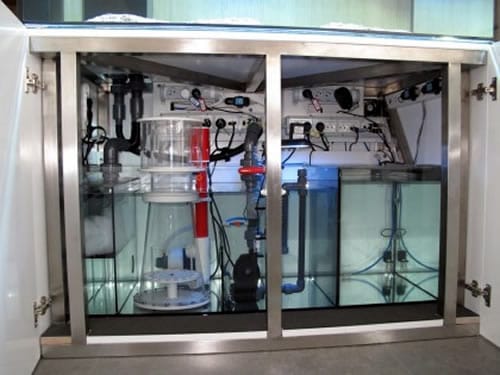What is a sump? An Aquarium Sump is another aquarium or container plumbed in beneath or to the side of the main display where Filters, Pumps, Heaters and other equipment can be hidden out of sight. Another purpose of a sump is to increase the aquarium’s stability by adding additional water volume.
Saltwater Aquarium Sumps
A saltwater aquarium sump is recommended for aquariums larger than 55 gallons, as it becomes very difficult to find affordable and adequate equipment for larger systems. Most hobbyists purchase a reef ready or pre-drilled aquarium with holes to incorporate a sump below the aquarium. Others use a Hang on the Back Overflow Box which is not recommended as it will eventually fail and flood your floor. If you would like to have a sump, but your aquarium is not drilled, you may also consider purchasing a new tank or drilling the aquarium yourself.

How Does An Aquarium Sump Work?
Until you see how a sump works, it can be quite confusing. Imagine two aquariums, one above the other. The top aquarium has two holes housed in an overflow box. One hole acts like a drain and moves water from the top aquarium to the bottom aquarium. The other hole acts like a return and moves water from the bottom of the aquarium back up to the top aquarium. When a pump located in the bottom aquarium is turned on, water from the bottom tank moves up to the top tank. The top tank begins to fill with water and drains into the overflow box. Eventually, the overflow box fills and begins to drain water back into the sump. Neither the top or bottom tank will flood because the system relies on gravity and equilibrium is maintained.
Most hobbyists house a Protein Skimmer or wet/dry filter in their sump. This provides for greater filtration than most hang on the back filters. Some hobbyists also create a Refugium to grow macroalgae and copepods for added filtration or to a feed a Mandarin Goby.
